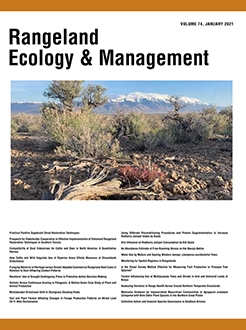Contemporary methods of rangeland health (RH) assessment evaluate indicators designed to assess land use impacts on ecosystem function. These methods have not been tested relative to variation in specific grazing practices, including grazing period length and stocking rates during the growing season. We report on RH outcomes for three habitat types (native grassland, tame pasture, and forested pasture) across 97 pastures on 28 beef cattle ranches in Alberta, Canada. Pastures were distributed along a climatic gradient encompassing the grassland, parkland/foothill, and boreal regions. Surveys of ranchers were used to quantify typical grazing period length (1 May–31 October) and, if applicable, rotation length, along with corresponding stocking rates for each pasture over the previous 5 yr. Pastures were assessed for RH using indicators of vegetation composition and structure, litter abundance, soil stability, weed presence, and within tame pastures, woody plant encroachment. An Akaike Information Criterion analysis compared the influence of aridity, grazing period length, and stocking rate on total range health scores (RHS) and ordination used to identify associations between indicator scores and grazing metrics. Total RHS varied among habitat types, being greater in forests than native and tame grasslands (P < 0.05), and declined with increasing forage utilization, particularly in forests. Within tame pastures, total RHS varied primarily in response to regional climate, with RHS decreasing as moisture deficits increased and declining with longer grazing periods during summer. Native grasslands also decreased in RHS in response to longer grazing periods, with stocking rates having little impact on RHS. Select RH indicators were associated with improved health in native grasslands grazed for shorter periods including low weed abundance and greater litter. Further studies are recommended to understand how, over and above climatic influences, variation in grazing practices alter the health of northern temperate grasslands.
How to translate text using browser tools
4 January 2021
Assessing Variation in Range Health Across Grazed Northern Temperate Grasslands
Kristine M. Dahl,
Edward W. Bork,
John R. Parkins,
Kate Sherren
ACCESS THE FULL ARTICLE
aridity
grazing period
habitat type
producer surveys
stocking rates





